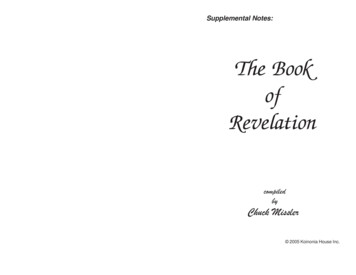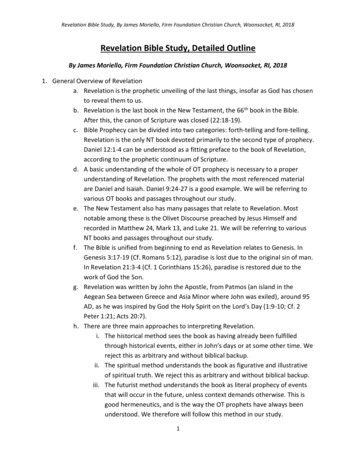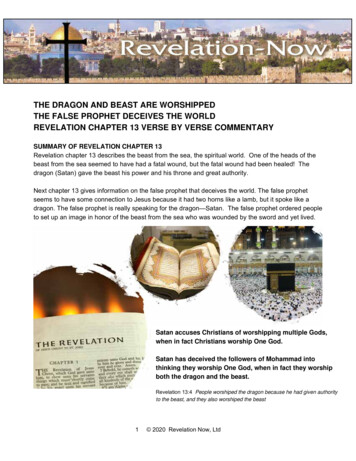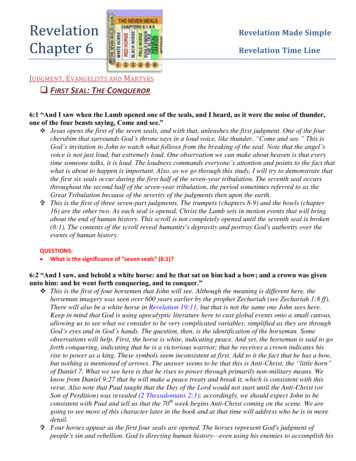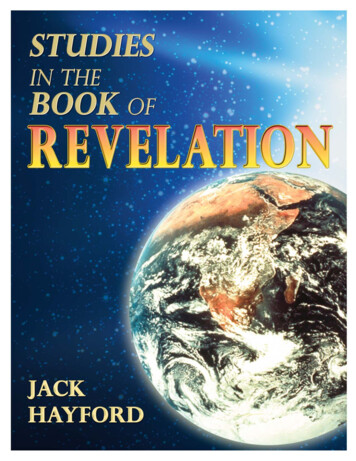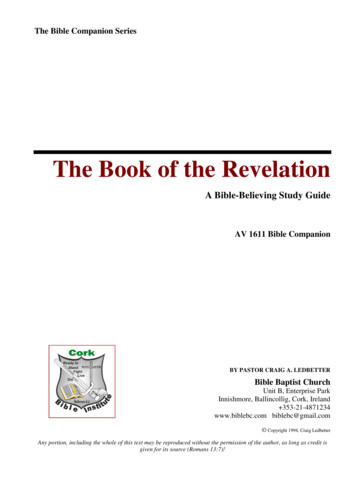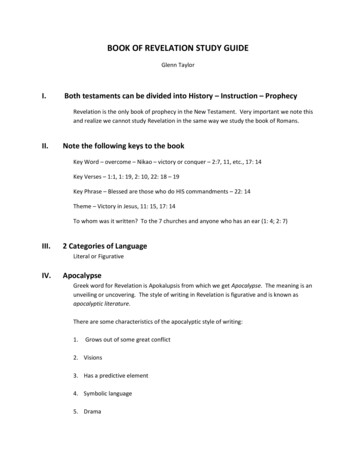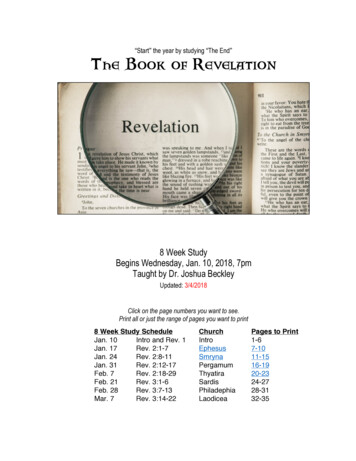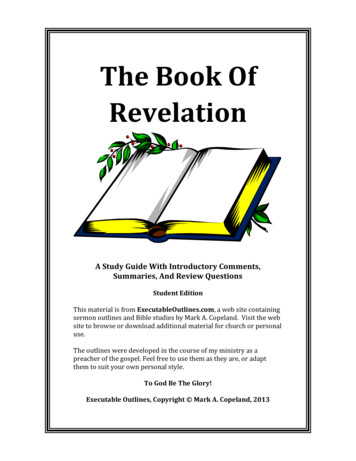
Transcription
The Book OfRevelationA Study Guide With Introductory Comments,Summaries, And Review QuestionsStudent EditionThis material is from ExecutableOutlines.com, a web site containingsermon outlines and Bible studies by Mark A. Copeland. Visit the website to browse or download additional material for church or personaluse.The outlines were developed in the course of my ministry as apreacher of the gospel. Feel free to use them as they are, or adaptthem to suit your own personal style.To God Be The Glory!Executable Outlines, Copyright Mark A. Copeland, 2013
2The Book Of RevelationTable Of ContentsIntroductionChapter OneChapter TwoChapter ThreeChapter FourChapter FiveChapter SixChapter SevenChapter EightChapter NineChapter TenChapter ElevenChapter TwelveChapter ThirteenChapter FourteenChapter FifteenChapter SixteenChapter SeventeenChapter EighteenChapter NineteenChapter TwentyChapter Twenty-OneChapter Twenty-TwoConcluding 196101This study guide was designed for adult Bible classes, though it might be suitable for juniorand senior high classes as well. Some have used it for personal devotions, and others insmall study groups. Points to ponder for each chapter are things I emphasize during the class. Detailed outlines for each chapter might be useful for sermon or class preparation. Review questions are intended to reinforce key thoughts in each chapter. There isa “teacher’s edition” available with answers included.ExecutableOutlines.com
3The Book Of RevelationIntroduction“The Revelation of Jesus Christ, which God gave Him to show His servants—things which mustshortly take place.” (Re 1:1)So begins the book of Revelation, one of the most challenging books in the Bible. It is thefirst book that many new to the Bible want to study, while it is often neglected by matureChristians. It has been used by false teachers and prophets to lead people into doomsdaycults. Yet when properly handled, it can be a wonderful blessing to those who read andmeditate upon it.Who wrote this book? How is it unique? How should we interpret it? Why should westudy it? These are questions we will seek to answer in this introduction.Unique Nature Of The BookRevelation is certainly different from other books of the New Testament. It is also verydifferent from any kind of writing that is familiar to most people today. Unfortunately, thishas caused some people to shy away from the book; or on the other hand, to misuse it inpropagating wild and fanciful theories. Most people conclude it is just too mysterious tounderstand. But it was actually written to make things clearer! The word “revelation” inthe Greek is apokalupsis, which means “an uncovering” or “unveiling.” It is therefore abook designed to uncover or unveil, not conceal.Part of the challenge in understanding the book is that it is written in a style not familiar tomodern man. It is an example of what is called “apocalyptic literature” which was quitepopular from 200 B.C. to 200 A.D. As such, it was a type of literature well known to the Jewsand Christians of the first century church. Features of apocalyptic literature include the useof highly symbolic or figurative language (cf. “signified”, Re 1:1). It was normally written intimes of persecution, usually depicting the conflict between good and evil.There are other examples of apocalyptic literature in the Bible. In the Old Testament, forexample, the books of Ezekiel, Daniel, and Zechariah each contain elements of this style ofwriting. In the New Testament, Matthew 24 contains apocalyptic elements.Understanding The BookThe early church likely did not have the problem understanding the book as we do today.They were well acquainted with the style of apocalyptic literature. They were living at atime when the symbols of the book were likely familiar to them (similar to how a picture ofa donkey fighting an elephant would be understood by us as depicting conflict between theDemocratic and Republican parties). In fact, I believe the book was originally intended to beunderstood by a casual hearing, as implied by the opening beatitude:“Blessed is he who reads and those who hear the words of this prophecy, and keep those thingswhich are written in it; for the time is near.” (Re 1:3)This verse suggests a setting in which one is reading while others listen. The listeners wereexpected to understand enough to be blessed by what they heard.ExecutableOutlines.com
4Our difficulty with this book is due to our unfamiliarity with apocalyptic literature as amethod of communicating a message. We are also far removed from the historical andcultural context of the times which would make the symbolism easier to understand. Toproperly interpret the book, we must try to understand the historical context in which itwas written. We must also interpret it in a manner that would have been meaningful tothose to whom it was first addressed. It also behooves us to pay close attention to thosepassages or statements which are clear and easy to understand.Methods Of InterpretationDifferent methods of interpreting the book generally fall into four views:The “preterist” view - The book refers to events that were fulfilled in the first century A.D.,or shortly thereafter. It was written primarily to encourage the original readers. Its valuefor today would therefore be didactic (teaching the value of faithfulness to God).The “historicist” view - The book provides a panoramic view of the experience of thechurch as it proceeds throughout history. This view finds in the book such events as therise of Catholicism, Islam, the Protestant reformation, world wars, etc., ending with thereturn of Christ. As such it would encourage Christians no matter when they lived.The “futurist” view - Apart from the first few chapters, the book depicts events whichimmediately precede the second coming of Christ. Therefore most of the book has yet to befulfilled (or is being fulfilled now), and its value is primarily for Christians who will be livingat the time Jesus returns.The “idealist” view - The book does not deal with any specific historical situation. Instead,it is simply enforcing the principle that good will ultimately triumph over evil. As such thebook is applicable to any age.Preferred Method Of InterpretationI believe a proper interpretation of the book incorporates some of all these views. In myestimation, the “preterist” view has the most merit for the following reasons: The book was written specifically to seven churches in Asia (modern Turkey) - Re1:4 Its purpose was to uncover or reveal “things which must shortly come to pass” - Re1:1,3; 22:6,10 John was told, “Do not seal the words of the prophecy of this book, for the time is athand” - Re 22:10Compare the last two points with Daniel 8:26, where Daniel was told to “seal up” his vision,“for it refers to many days in the future”. We know that his vision was fulfilled withinseveral hundred years. John, however, was told “do not seal” what he had seen, “for thetime is at hand”. How could this be, if the bulk of Revelation refers to what has yet to occuralmost two thousands later? This is a problem I see with the “futurist” view, which placesprimary fulfillment of the book thousands of years after its composition.Place yourself in the position of those Christians in the churches of Asia in the first century.They were told that the things described in the Revelation would “shortly come to pass”,which should comfort them. But according to the “futurist” view, it has been nearly 2000years and much of the book has yet to be fulfilled! That would be like someone todaywriting that something is soon coming to pass, when in reality it will be 4000 A.D. before itExecutableOutlines.com
5does! How would a book depicting events to occur thousands of years in the futurecomfort those who were suffering in the first century A.D.?This is not to say there are no “futurist” elements in the book. I understand chapters 20-22to deal with the ultimate destiny of the redeemed, which would have been of great interestand comfort to the Christians suffering in the first century.My approach to the book, therefore, will be primarily from the preterist viewpoint, withoccasional elements from other viewpoints.The AuthorJohn, identified as one “who bore witness to the word of God, and to the testimony of JesusChrist” (Re 1:1-2). While debated by some, he was most likely the apostle John, brother ofJames, and author of the gospel of John and three epistles. His authorship of this book issupported by the testimony of Justin Martyr (165 A.D.), Clement of Alexandria (220 A.D.),Hippolytus (236 A.D.), and Origen (254 A.D.).Date Of The BookDating when the book was written is not without controversy. When one dates the bookwill certainly have a bearing upon one’s interpretation of the book, especially if one followsthe “preterist” view. Two dates are usually proposed: An “early date”, around 64-68 A.D., during the reign of the Roman emperor, Nero A “late date”, around 95-96 A.D., during the reign of emperor DomitianThe external evidence (evidence outside the book itself) is inconclusive. In support for thelate date, appeal is often made to a statement of Iraneaus who lived in the late 2nd centuryA.D. His statement is rather ambiguous, however, and can be understood in several ways(see Redating The New Testament, by John A. T. Robinson, for a detailed examination ofIraneaus’ quotation).In support for the early date, the Syriac version of the New Testament (dating back to the2nd century A.D.) says the book was written during the reign of Nero. The MuratorianFragment (170-190 A.D.) and the Monarchian Prologues (250-350 A.D.) claim that Paulwrote to seven churches following the pattern of John’s example in Revelation, placing thebook of Revelation even before some of the Pauline epistles (Expositor’s Bible Commentary,Vol. 12; p. 406).Because of the contradictory nature of the external evidence, I place more weight on theinternal evidence (evidence from within the book itself). I believe the book itself supports adate of 70 A.D., before the destruction of Jerusalem and during the reign of Vespasian.This internal evidence includes the following: In Re 11:1-14 the temple, which was demolished in August of 70 A.D., is stillstanding. Advocates of the “late date” naturally understand this passage in a strictlyfigurative sense. While somewhat figurative, the allusion to the crucifixion of ourLord (Re 11:8) compel us to think of the historical Jerusalem (Philip Schaff). In Re 17:9-11, we find mention of EIGHT “kings”. If these “kings” are emperors ofRome, then starting with Augustus the first FIVE were: Augustus, Tiberius, Caligula,Claudius and Nero (who died June 9, 68 A.D.). Nero’s death left the empire in anuproar. This may be the “deadly wound” in Re 13:3,12,14. Three men (Galba, Otho,ExecutableOutlines.com
6and Vitellius) tried vainly to consolidate power over the empire, but it wasVespasian who restored order in 70 A.D. Thus, the “deadly wound” was healed, andVespasian would be the SIXTH “king” (or the “one is” in Re 17:10). This wouldmake Titus the SEVENTH emperor and Domitian the EIGHTH. Notice carefully, that in Re 17:8,11 John was told that the beast “is not”. It “was”,and “is about to come” (ASV), but at the time the Revelation was being given, thebeast “IS NOT”! If we understand (as I do) that the “beast” represents imperialRome as personified in its emperors Nero and Domitian, then Revelation could NOThave been written during the reigns of either Nero or Domitian! The condition of persecution that had been experienced already by those in thebook are similar to that mentioned by Peter. He wrote to the Christians in AsiaMinor also, just a few years before (cf. 1Pe 1:1). They were undergoing persecutionsimilar to that described in Re 2 & 3 (cf. 1Pe 1:6; 4:12; 5:9); i.e., persecution by theJews with the help of Roman authorities, something that had been going on since thedays of Paul’s first missionary journey.Therefore I suggest the internal evidence indicates that the Revelation was given during thereign of VESPASIAN, the SIXTH emperor, while the “beast is not”. This would place the dateof the book around the spring of 70 A.D. (as suggested by Philip Schaff, History Of TheChurch, Vol. I). A date between the death of Nero in 68 A.D. and the fall of Jerusalem in 70A.D. was also favored by F. J. A. Hort, J. B. Lightfoot, and B. F. Westcott (John A. T. Robinson,Redating The New Testament, p. 224). Another advocate of an early date is F. F. Bruce.Referring to Philip Schaff, who at one time held the “late date”, I find his following quotationto be of interest:“The early date is best suited for the nature and object of the Apocalypse, andfacilitates its historical understanding. Christ pointed in his eschatologicaldiscourses to the destruction of Jerusalem and the preceding tribulation asthe great crisis in the history of the theocracy and the type of the judgment ofthe world. And there never was a more alarming state of society.”“The horrors of the French Revolution were confined to one country, but thetribulation of the six years preceding the destruction of Jerusalem extendedover the whole Roman empire and embraced wars and rebellions, frequentand unusual conflagrations, earthquakes and famines and plagues, and allsorts of public calamities and miseries untold. It seemed, indeed, that theworld, shaken to its very center, was coming to a close, and every Christianmust have felt that the prophecies of Christ were being fulfilled before hiseyes.”“It was at this unique juncture in the history of mankind that St. John, with theconsuming fire in Rome and the infernal spectacle of the Neronianpersecution behind him, the terrors of the Jewish war and the Romaninterregnum around him, and the catastrophe of Jerusalem and the Jewishtheocracy before him, received those wonderful visions of the impendingconflicts and final triumphs of the Christian church. His was truly a book ofthe times and for the times, and administered to the persecuted brethren theone but all-sufficient consolation: Maranatha! Maranatha!” (History of TheChristian Church, Vol. I, pp. 836-837)ExecutableOutlines.com
7The Purpose Of The BookIts purpose is clearly stated at the beginning and end of the book (cf. Re 1:1,3; 22:6,10):To reveal “things which must shortly come to pass”In particular, it is a revelation from Christ Himself of the judgment to come upon those whowere persecuting His people (cf. Re 6:9-11; 16:5-7). This judgment was directed especiallytoward those who had been deceived by Satan to attack the Church of Christ. As stated byPhilip Schaff:“Undoubtedly he had in view primarily the overthrow of Jerusalem andheathen Rome, the two great foes of Christianity at that time.”Again, I would suggest that the purpose of the book is to reveal how Christ was going tobring judgment on Jerusalem and Rome for rejecting God and persecuting His people. Thisjudgment occurred with the destruction of Jerusalem in the fall of 70 A.D., and with the finalcessation of persecution by Rome in 313 A.D. when Constantine became an emperorsupportive of Christianity.In fulfilling this purpose, the book is designed to warn and comfort. For erring disciples, itis a book of warning (“repent” or else, cf. Re 2:5,16). For faithful disciples, it is a book ofcomfort (“blessed” are those who “overcome”, cf. Re 1:3; 2:7; 3:21; 14:13; 22:14).Key VerseIf there is one verse that summarizes the theme of the book of Revelation, it is this one:“These will make war with the Lamb, and the Lamb will overcome them, for He is Lord of lordsand King of kings; and those who are with Him are called, chosen, and faithful.” (Re 17:14)OutlineINTRODUCTORY MATERIAL (Re 1:1-3:22)1. Introduction (Re 1:1-20)a. Prologue and blessings (Re 1:1-3)b. Greetings and doxology (Re 1:4-6)c. Prophecy and proclamation (Re 1:7-8)c. Vision of Christ among the lampstands (Re 1:9-20)2. Letters to the seven churches of Asia (Re 2:1-3:22)a. The church at Ephesus (Re 2:1-7)b. The church at Smyrna (Re 2:8-11)c. The church at Pergamos (Re 2:12-17)d. The church at Thyatira (Re 2:18-29)e. The church at Sardis (Re 3:1-6)f. The church at Philadelphia (Re 3:7-13)g. The church at Laodicea (Re 3:14-22)I.VISIONS OF JUDGMENT AGAINST JERUSALEM (Re 4:1-11:19)A. THE THRONE SCENE (Re 4:1-5:14)1. God on the throne (Re 4:1-11)2. The Lamb worthy to open the scroll (Re 5:1-14)ExecutableOutlines.com
8B. THE OPENING OF SEVEN SEALS (Re 6:1-8:1)1. First seal: The white horse and its rider (Re 6:1-2)2. Second seal: The red horse and its rider (Re 6:3-4)3. Third seal: The black horse and its rider (Re 6:5-6)4. Fourth seal: The pale horse and its riders (Re 6:7-8)5. Fifth seal: The martyrs under the altar (Re 6:9-11)6. Sixth seal: Cataclysmic disturbances (Re 6:12-17)7. Interlude (Re 7:1-17)a. Sealing of the 144,000 on earth (Re 7:1-8)b. The great multitude in heaven (Re 7:9-17)8. Seventh seal: Silence in heaven (Re 8:1)C. THE SOUNDING OF SEVEN TRUMPETS (Re 8:2-11:19)1. Seven angels prepare to sound their trumpets (Re 8:2-6)2. First trumpet: Third of vegetation destroyed (Re 8:7)3. Second trumpet: Third of sea creatures and ships destroyed (Re 8:8-9)4. Third trumpet: Third of rivers and springs become bitter, many die (Re 8:10-11)5. Fourth trumpet: Third of sun, moon, and stars struck, affecting day and night(Re 8:12)6. Three-fold woe announced (Re 8:13)7. Fifth trumpet (first woe): Locusts from the bottomless pit, sent to torment men(Re 9:1-12)8. Sixth trumpet (second woe): Four angels with an army of two hundred million,killing a third of mankind (Re 9:13-21)9. Interlude (Re 10:1-11:14)a. The angel with the little book (Re 10:1-11)b. The two witnesses and destruction of Jerusalem (Re 11:1-13)10. Seventh trumpet (third woe): The victory of Christ and His kingdom proclaimed(Re 11:14-19)II. VISIONS OF JUDGMENT AGAINST ROME (Re 12:1-19:21)A. THE GREAT CONFLICT (Re 12:1-14:20)1. The Woman, Child, Dragon, and rest of the Woman’s offspring (Re 12:1-17)2. The beast from the sea (Re 13:1-10)3. The beast from the land (Re 13:11-18)4. The Lamb and the 144,000 on Mount Zion (Re 14:1-5)5. Proclamations of three angels (Re 14:6-13)6. Reaping the earth’s harvest, and the grapes of wrath (Re 14:14-20)B. THE SEVEN BOWLS OF WRATH (Re 15:1-16:21)1. Prelude to pouring out the seven bowls of wrath (Re 15:1-8)2. First bowl: Sores on those who worshipped the beast and his image (Re 16:1-2)3. Second bowl: Sea turns to blood, all sea creatures die (Re 16:3)4. Third bowl: Rivers and springs turn to blood (Re 16:4-7)5. Fourth bowl: Men are scorched by the sun (Re 16:8-9)6. Fifth bowl: Pain and darkness upon the beast and his kingdom (Re 16:10-11)7. Sixth bowl: Euphrates dried up, three unclean spirits gather the kingdoms of theearth for the battle at Armageddon (Re 16:12-16)ExecutableOutlines.com
98. Seventh bowl: Great earthquake, great city divided, Babylon is remembered,cataclysmic events (Re 16:17-21)C. THE FALL OF BABYLON, THE HARLOT (Re 17:1-19:10)1. The scarlet woman and the scarlet beast (Re 17:1-6)2. The mystery of the woman and beast explained (Re 17:7-18)3. The fall of Babylon the great proclaimed and mourned (Re 18:1-24)4. The exaltation in heaven over the fall of the great harlot (Re 19:1-5)5. The announcement of the marriage supper of the Lamb (Re 19:6-10)D. THE DEFEAT OF THE BEAST AND FALSE PROHET (19:11-21)1. Christ the victorious warrior and King of kings (Re 19:11-16)2. The beast, his armies and false prophet (land beast) are defeated (Re 19:17-21)III. VISIONS OF THE FUTURE AND BEYOND (Re 20:1-22:5)A. THE REIGN OF CHRIST AND HIS SAINTS (Re 20:1-6)1. Satan bound for a thousand years, unable to deceive nations (Re 20:1-3)2. Saints (martyrs and faithful) reign with Christ (Re 20:4-6)B. THE RELEASE AND DEFEAT OF SATAN (Re 20:7-10)1. Satan released to deceive the nations once more (Re 20:7-8)2. Makes one last effort, but defeated once for all (Re 20:9-10)C. THE FINAL JUDGMENT (Re 20:11-15)1. Great white throne judgment, with earth and heaven no more (Re 20:11-13)2. Death and Hades cast into the lake of fire, along with those whose names werenot in the Book of Life (Re 20:14-15)D. ETERNAL DESTINY OF THE REDEEMED (Re 21:1-22:5)1. The new heaven and new earth, God dwelling with His people in the NewJerusalem coming down out of heaven(Re 21:1-8)2. The New Jerusalem described (Re 21:9-27)3. The water of life, tree of life, throne of God and the Lamb (Re 22:1-5)CONCLUDING MATERIAL (Re 22:6-21)1. The time is near, do not seal up the book (Re 22:6-11)2. The testimony of Jesus, the Spirit, and the bride (Re 22:12-17)3. Warning not to tamper with the book, and closing prayers (Re 22:18-21)Review Questions1) What is this book called? (1:1)2) What is the meaning of the Greek word (apokalupsis) translated “revelation”?3) What style of literature is the book of Revelation?ExecutableOutlines.com
104) What are some of the typical features of such literature?5) What is important to know to properly interpret the book?6) What are the four major views of interpreting the book?7) Which view is suggested in this introduction?8) Who is the author of this book? (1:1-2)9) What dates are usually suggested for the book?10) Which date is suggested in this study? (and by Schaff, McGuiggan, and others)11) What is the purpose of the book? (1:13; 22:10,16)12) Who do I propose to be the two major enemies used by Satan?13) What is the key verse that summarizes the book?14) From the outline above, what are the three main divisions of the book?Bibliography(those marked with an asterisk * I found especially helpful)Back To The Future: A study in the book of Revelation, R. E. Bass (Living Hope Press, 2004) *The Book Of Revelation, Jim McGuiggan (Montex, 1976)The Book Of Revelation, Foy E. Wallace, Jr. (Wallace Publications, 1966)History Of The Christian Church, Vol. I, Philip Schaff (Eerdmans, 1910, 1985)The Lamb And His Enemies, Rubel Shelly (20th Century, 1985)The Message From Patmos, David S. Clark (Titus Books, 2013) *More Than Conquerors, William Hendricksen (Baker Book House, 1971)New International Bible commentary, F. F. Bruce (Zondervan Publishing House, 1979)Redating The New Testament, John A. T. Robertson (Westminster Press, 1976)Revelation, Robert Harkrider (Truth Commentaries, Guardian Of Truth, 1997)Revelation, Four Views: A Parallel Commentary, Steve Gregg Nelson Publishers, 1997) *Revelation: An Introduction And Commentary, Homer Hailey (Baker, 1979)The Time Is At Hand, Jay Edward Adams (Timeless Texts, 2004) *Worthy Is The Lamb, Ray Summers (Broadman Press, 1951)ExecutableOutlines.com
11The Book Of RevelationChapter OneThe Revelation of Jesus Christ begins with a clear statement of origin and purpose. Given toJesus by God to show His servants things which must soon take place, it is designed to blessthose who read, hear and keep the words of the prophecy (1-3). John then addresses theseven churches in Asia (western Turkey), offering grace and peace from each member of theGodhead with descriptive terms which become more significant later in the epistle (4-6).His greeting is followed with a declaration concerning the Lord’s coming, and a selfdesignation as expressed by the Lord Himself (7-8).At this point John explains how he was commissioned to record the Revelation. While onthe island of Patmos (likely in exile for preaching the word of God), he was in the Spirit onthe Lord’s day when he heard a loud voice behind him. The voice identified itself as “theAlpha and Omega, the First and the Last”, and then charged him to write what he saw toseven churches in Asia (9-11). Turning to see the voice, John saw seven golden lampstandsand in their midst the Son of Man. Describing the awesome appearance of the Son of Manand his own reaction, John then records how Jesus comforted and then charged him to writewhat he has seen and will see (12-19). The chapter ends with the Lord’s explanation thatthe seven stars in His right hand represent the angels (messengers?) of the seven churches,and the seven lampstands signify the seven churches themselves (20).Points To Ponder That the book was written to specific churches of things that would soon take place The implications of what is said about Jesus, in the greeting by John and in thewords of Jesus HimselfOutlineI.INTRODUCTION (1-8)A. INTRODUCTION AND BENEDICTION (1-3)1. Introducing the Revelation of Jesus Christ (1-2)a. Which God gave Him to show His servantsb. Regarding things which much shortly take placec. Sent and signified by His angeld. To His servant John, who bore witness.1) To the word of God2) To the testimony of Jesus Christ3) To all things that he saw2. The benediction (3)a. Blessed is he who reads and those who hear this prophecyb. Blessed are those who keep those things written in it, for the time is nearB. GREETINGS TO THE SEVEN CHURCHES (4-6)1. From John, to the seven churches in Asia (4a)ExecutableOutlines.com
122. With grace and peace (4b-6)a. From Him who is and who was and who is to comeb. From the seven Spirits who are before His thronec. From Jesus Christ1) The faithful witness2) The firstborn from the dead3) The ruler over the kings of the earth4) Who loved us and washed us from our sins in His own blood5) Who made us kings and priests to His God and Father-- To Whom be glory and dominion forever and ever!C. ANNOUNCEMENT OF CHRIST’S COMING (7)1. He is coming with clouds2. Every eye will see Him, and they also who pierced Him3. All the tribes of the earth will mourn because of Him-- Even so, Amen (so be it)D. THE SELF-DESIGNATION (8)1. “I am the Alpha and the Omega, the Beginning and the End”2. “Who is and who was and who is to come, the Almighty”II. THE VISION OF THE SON OF MAN (9-20)A. JOHN’S CIRCUMSTANCES LEADING UP TO THE VISION (9-10a)1. Their brother and companion (9a)a. In tribulationb. In the kingdom and patience of Jesus Christ2. On the island called Patmos (9b)a. For the word of Godb. For the testimony of Jesus Christ3. In the Spirit on the Lord’s Day (10a)B. WHAT HE HEARD BEHIND HIM (10b-11)1. A loud voice, as of a trumpet (10b)2. Saying to him. (11)a. “I am the Alpha and the Omega, the First and the Last”b. “What you see, write in a book”c. “Send it to the seven churches which are in Asia.”C. WHAT HE SAW, AND HIS REACTION (12-17a)1. Turning to see the voice, he saw. (12-16)a. Seven golden lampstandsb. In the midst of the seven lampstands, One like the Son of Man1) Clothed with a garment down to the feet, girded about the chest with agolden band2) His head and hair white as wool, white as snow3) His eyes like a flame of fire4) His feet like fine brass, as if refined in a furnace5) His voice as the sound of many waters6) In His right hand, seven starsExecutableOutlines.com
137) Out of His mouth, a sharp two-edged sword8) His countenance like the sun shining in its strength2. Seeing Him, John fell at His feet as dead (17)D. THE LORD’S WORDS TO JOHN (17b-20)1. “Do not be afraid” (17b-18)a. “I am the First and the Last”b. “I am He who lives, and was dead, and behold, I am alive forevermore.Amen.”c. “I have the keys of Hades and of Death.”2. “Write.” (19)a. “The things which you have seen”b. “The things which are”c. “The things which will take place after this”3. “The mystery of the seven stars.and the seven golden lampstands” (20)a. “The seven stars are the angels of the seven churches”b. “The seven lampstands.are the seven churches”Review Questions1) What are the main points of this chapter?2) What was Jesus intending to show His servants? (1)3) How is John described in verse 2?4) Who is this book designed to bless? Why? (3)5) To whom was the book addressed? (4,11)6) How is God described in the greeting from John? The Holy Spirit? (4)7) How is Jesus Christ described by John in this greeting? (5-6)8) What is said about the coming of Christ? (7)ExecutableOutlines.com
149) How does the Lord designate Himself? (8)10) How does John identify himself to His readers? (9a)11) Where and when did John receive the Revelation? (9b-10)12) What did he hear a loud voice say? (11)13) When he turned to see the voice, what did he see? (12-13)14) How does John describe the Son of Man? (13-16)15) What was John’s reaction when he saw Him? What was he first told? (17)16) How does the Son of Man identify Himself? (17-18)17) What was John told to write? (19)18) What is the explanation of the seven stars and seven golden lampstands? (20)ExecutableOutlines.com
15The Book Of RevelationChapter TwoIn this chapter John is instructed to write to four churches in Asia: Ephesus, Smyrna,Pergamos, and Thyatira. The Lord generally follows the same format: His selfdesignation, commendation, condemnation and related warning, exhortation and promise.Each letter closes with the admonition, “He who has an ear, let him hear what the Spiritsays to the churches.” This suggests the letters were not just for the personal benefit of thechurches addressed.The church at Ephesus is commended for its steadfastness, especially against false apostles.But while standing for the truth, they had lost their first love. Exhorted to repent and berestored by doing the “first works”, they are warned that their “lampstand” would beremoved if they did not repent (1-7).The church at Smyrna is commended for being “rich” despite their tribulation and poverty.Unlike most churches, there are no words of condemnation directed toward it. While theywould experience a little persecution, they are exhorted to remain faithful to death (8-11).The church at Pergamos is also praised for its steadfastness, but faulted for allowing falseteachers in their midst. The Lord threatens to come and fight with the sword of His mouth ifthere is no repentance (12-17).The church at Thyatira is also commended, for their last works are more than their first.But they too have a false teacher and followers which jeopardize the condition of thechurch. Despite
The Book Of Revelation Introduction “The Revelation of Jesus Christ, which God gave Him to show His servants—things which must shortly take place.” (Re 1:1) So begins the book of Revelation, one of the most challenging books in the Bible. It is the first book that many new to the B

